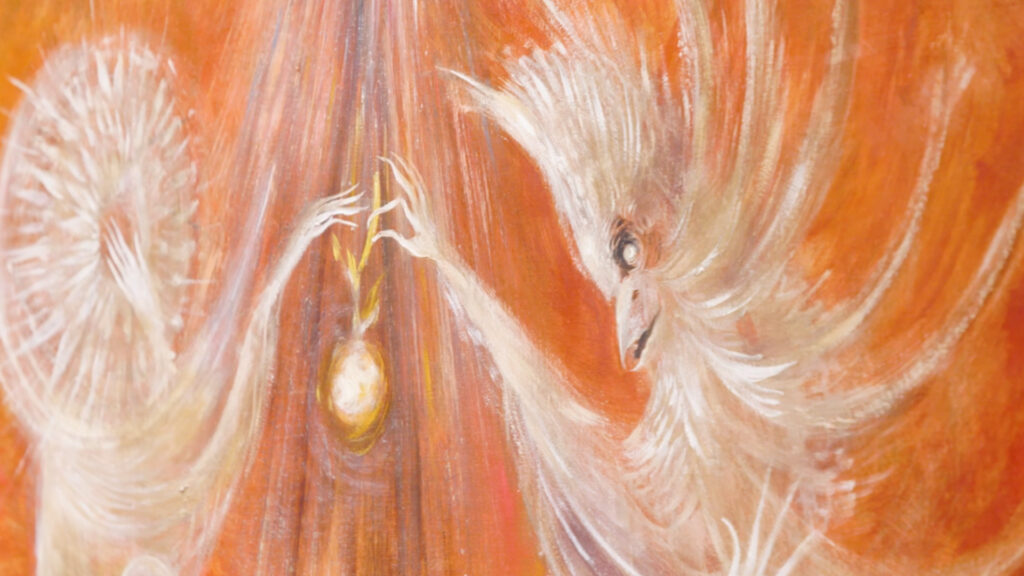I didn’t have time to be anyone’s muse…I was too busy rebelling against my family and learning to be an artist. – Leonora Carrington
In some ways, Surrealist Leonora Carrington’s story is a familiar one, given her gender and generation.
A creative young woman, stifled by her conventional upbringing, escapes to Paris, falls in love with an older male artist, gains a degree of recognition destined always to be smaller than that of her celebrated lover’s, suffers hardships, continues working, lives a very long time and is the subject of nearly as many exhibitions in the decade and a half following her death as in the 70 years preceding it.
Certainly, Carrington, who died in 2011, would be deeply rankled by this, or any attempt to condense her narrative into an easily-grasped package. Witness the brusque way she rejects her younger cousin Joanna Moorhead‘s invitations, above, to describe the inspiration behind various canvases:
You’re trying to intellectualize something, desperately, and you’re wasting your time! That’s not a way of understanding to make …a sort of mini logic. You’ll never understand by that road.
The story of how Moorhead connected with her notorious cousin is a fascinating one.
Growing up in England, Moorhead knew next to nothing about the family’s absent black sheep – who had taken up with the 46-year-old Max Ernst at the age of 20, hobnobbed with Picasso, Marcel Duchamp and Andre Breton in Paris, and wound up in Mexico City after WWII.
All she was told was that Carrington, known to the family as Prim, had “run off with an artist to become his model.”
As Moorhead writes in The Surreal Life of Leonora Carrington:
…there were occasional snatches: a hushed phone call where the word ‘Mexico’ was just audible; a whispered conversation on the sofa after Sunday lunch between (great aunt) Maurie and (grandmother) Miriam. There were guffawas occasionally from (uncle) Gerard and my father: “And then she painted a creature with three breasts!”
In 2006, Moorhead was at a party, making polite conversation with another guest, an art historian who lived in Mexico, “scrap(ing) together a few questions about the only Mexican artist I knew anything about – Frida Kahlo”, when she suddenly remembered her bohemian and seldom spoken of relative, who might even be dead by now for all she knew…
Her fellow guest was amazed by both the blood connection and Moorhead’s ignorance, describing Carrington as Mexico’s most famous living artist, and a “national treasure” who Mexico happily claimed as one of its own.
Gobsmacked, Moorhead Googled “Leonora Carrington”, discovering a wealth of photos from various phases of life, as well as the prodigious output from her brush:
A strange, Hieronymus Bosch-style world filed with horse-like creatures who floated, danced and curled their way across alien landscapes…Some of her pictures depicted unfamiliar and sinister-looking worlds: one showed a country with. Red sky and amber hills across which trapised a procession of people wearing white robes. More figures, wearing black, huddled around a huge eunuch like creature, while an outsize turquoise snake unfurled itself dramatically in mid-air. There seemed to be various elements competing to be the centre of the action in that painting: a globe, a God-like effigy and a cathedral all nestled below a rainbow. And the story, whatever it was, didn’t end there because (Carrington) had painted an underworld in which more people (dead, presumably) seemed to have been transformed into animals with pointy, black heads. They were crawling, or trying to crawl, and their efforts were being watched, ominously, by a sharp-toothed, one-eyed tiger.
Driven to find out more, Moorhead traveled to Mexico City, where Carrington had lived off and on since 1942. Her cousin was now in her late 80s, isolated with an infirm second husband, but still painting and championing Surrealism as a visual expression that couldn’t be captured with words:
There was no softness around the edges with Leonora; she had taken a hard path, suffered a great deal as a result, and she wore her toughness like a badge of honour she had earned from herself. It is far more of an honour than the certificate Blu-Tacked to her cupboard door, the honour the Mexican government had given her; it was certainly more of an honour than the OBE she had belatedly been awarded by the British, receiving it on a visit from Prince Charles on a visit he made to Mexico in 2000. She was bemused by these late accolades, but never impressed by them. Early on in her life, she had decided there was only one thing she could ever rely on, and that was the steeliness in her heart. External events, the trappings of wealth and success, the opinions of others, all these were swept away, dismissed, ignored. She was as unconcerned by the approval of others as by their disapproval.
See more of Leonora Carrington’s work here.
Listen to Joanna Moorhead interviewed about Leonora Carrington on the Great Women Artists Podcast (with the understanding that the subject would have resisted that gender-based categorization…). And read more about her at The New Yorker.
Related Content
The Forgotten Women of Surrealism: A Magical, Short Animated Film
When The Surrealists Expelled Salvador Dalí for “the Glorification of Hitlerian Fascism” (1934)
Ayun Halliday is the Chief Primatologist of the East Village Inky zine and author, most recently, of Creative, Not Famous: The Small Potato Manifesto and Creative, Not Famous Activity Book. Follow her @AyunHalliday.
